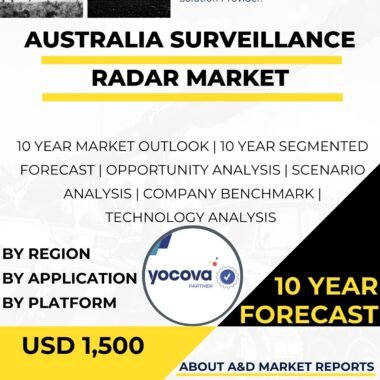Description
Brazil’s SISFRON Program and Integrated Surveillance Radar Systems
Brazil surveillance radar market is significantly advanced by the Integrated Border Monitoring System (SISFRON), a strategic initiative to enhance airspace and border security through advanced radar technologies. This program strengthens Brazil’s situational awareness, supports self-reliance, and fosters defense industry growth by integrating indigenous and collaborative radar solutions.
SISFRON’s Radar Integration for Border Security
SISFRON, launched to monitor Brazil’s 16,886-km land border, deploys a network of ground-based and airborne surveillance radars, including Embraer’s SENTIR-M20 and SABER-M60 systems. These radars, developed with Army Technological Center (CTEx) support, offer 20-60 km detection ranges for aircraft, vehicles, and drones, enhancing real-time threat detection along remote Amazon and southern borders. Integrated with C4ISR (Command, Control, Communications, Computers, Intelligence, Surveillance, and Reconnaissance) systems, SISFRON supports rapid response to illegal activities like smuggling and drug trafficking, tested in 2025 exercises in Mato Grosso do Sul.
Indigenous Development and Embraer’s Role
Embraer, through its Savis and Bradar subsidiaries, leads radar production at São José dos Campos, achieving over 70% local content. The SABER-M60, a compact AESA radar, provides 3D tracking for low-flying targets, while SENTIR-M20 supports mobile units for border patrols. These efforts, backed by technology transfers from Thales, train Brazilian engineers and create high-tech jobs, aligning with the National Defense Strategy to reduce foreign dependency.
Applications in Defense and Civilian Domains
SISFRON’s radars bolster air defense by detecting unauthorized aircraft, complementing FAB’s air traffic control for civilian airspace safety. Coastal versions, integrated with the Brazilian Navy, monitor maritime threats, protecting offshore oil assets. The systems also support humanitarian missions by tracking environmental threats like wildfires, enhancing Brazil’s disaster response capabilities.
Regional Impact and Export Potential
SISFRON’s success positions Brazil as a radar technology exporter, with interest from Colombia and Peru. The program contributes to Latin America’s surveillance radar market, fostering regional security cooperation through exercises like Operação Amazônia. Partnerships with global firms like Thales enhance Brazil’s technological edge and export viability.
In summary, SISFRON’s radar integration drives Brazil’s surveillance capabilities, enhancing border and airspace security while promoting self-reliance. By leveraging indigenous innovation and international collaboration, Brazil strengthens its role as a leader in Latin American defense technology.




